Insects are the most populous Class of animals with about 900,000 named species, this is about 3/4 of all named animals. There are estimated to be perhaps 30 million species of animals, with the current proportion of insects under-representative. Many species are of great economic importance as pests or pollinators and many spread human diseases.
Insecta - Insects
Typical Insects
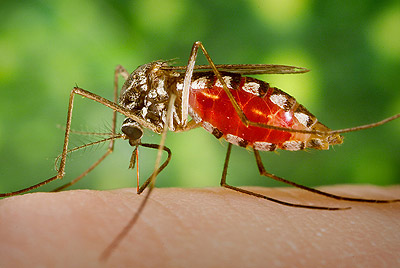
A mosquito, (Diptera) of the
Asian species Armigeres subalbatus
feeding on a human finger. A female needs protein for
her developing eggs, the males aren't bloodsuckers and
females only feed on blood when pregnant. Yes that red
stuff is blood filling up the mosquitoes abdomen, note
the straight proboscis that the mosquito is sucking
the blood through and the position of the head and thorax.
Imagine having a piece of sharpened 1/2" (15mm) pipe
stuck on the front of your head, you then have to hold
onto some tough skin with the claws at the end of your
arms and push it through, all without alerting the animal
you are trying to feed from in case it casually squashes
you or breaks your limbs and wings. If you fail, your
babies die.
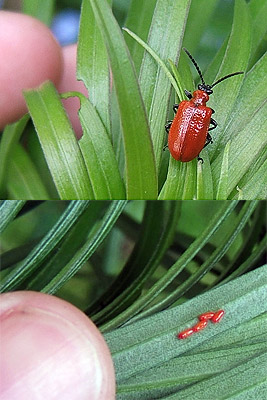
A Scarlet Lily Beetle, (Coleoptera)
Lilioceris lilii.
A small beetle
6-9mm (1/4-3/8") long that feeds on lilies and fritillaries
of various kinds. Adult and eggs which are laid under
leaves, finger for scale.
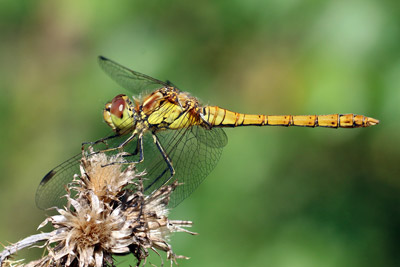
Common darter dragonfly
(Odonata)
Sympetrum striolatum.
Dragonflies
and damselflies are a widespread group of large carnivorous
insects. They live as aquatic larvae, sometimes for
several years before emerging for a single season as
flying adults
picture Charlessharp,
used under CC2.5 Attribution-Share Alike Generic License
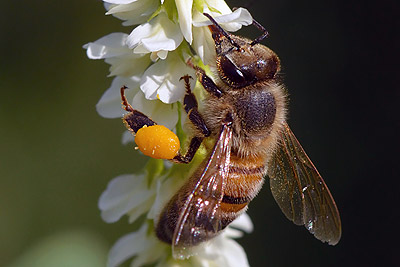
A Honey Bee, (Hymenoptera)
Apis mellifera.
Bees of all kinds
are invaluable as pollinators for wild plants and crops,
they collect pollen in a "pollen basket" on their hind
legs, the bright yellow mass you can see in this picture.
In the process of collecting pollen and nectar for their
own purposes, they conincidentally spread it from plant
to plant pollinating them.
Cool Insects
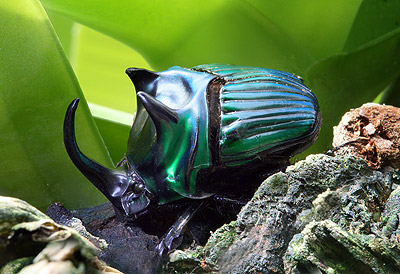
A male scarab beetle, (Coleoptera)
Oxysternon conspicillatum
The horns
are for intimidating and battling with other males for
access to females which don't have them
picture - Makro Freak, used
under Creative Commons
Attribution-Share Alike 2.5 Generic License

Atlas moth, (Lepidoptera)
Attacus atlas
The largest moth in the
world with a wingspan of over 25cm (10") and a wing
surface area upwards of 400 cm2. They are found in South
East Asia, particularly in the Malay Archipelago. This
one has probably just emerged from its cocoon, the brown
object that it is hanging from.
picture - Dr. Raju Kasambe,
used under Creative
Commons Attribution-Share Alike 3.0 Unported License

Leaf cutter ant (Hymenoptera)
These ants cut pieces of leaf of particular plants and
then take them to underground chambers. Here they allow
a fungus to grow on the leaves, the ants then feed on
the fungus rather than the leaves themselves.
picture -:Scott Bauer, US
Department of Agriculture, used under CC2.5 Attribution-Share
Alike Generic License

Little Clown Grasshopper (Orthoptera)
picture - Rose Thumboor, CC4
Attribution Share Alike International License

Morpho rhetenor (Lepidoptera)
picture -Didier Descouens,
CC4 Attribution Share Alike International License
Kingdom - Animalia
Phylum - Arthropoda
Class - Insecta
Basic Features:
Insects are a class in the Phylum Arthropoda, so
they have all of the characteristics of the
Arthropods.
- Body is divided into three parts, head, thorax and abdomen - the distinguishing feature of insects:
- Head has one pair of antennae.
- Thorax (middle bit) has three pairs of legs.
- Abdomen has no appendages.
- May have wings on the thorax, two pairs, one of which may be modified into a shell case or reduced or lost altogether.
- Mouth parts consist of a pair of mandibles (jaws), a pair of maxillae (to manipulate the food) and a labium (lip), these may be greatly modified for biting, chewing, piercing and sucking in different species.
- Gas exchange is by a tracheal system, with numerous openings to the outside along the thorax and abdomen called spiracles.
- Uric acid is produced as the nitrogenous waste product, this allows for the loss of a minimal amount of water.
- A tubular heart and simple circulatory system.
- Sexual reproduction with separate males and females, some can reproduce asexually as well.
What do insects eat?
You name it, the chances are there's an insect that will eat it.
Many insects undergo a process called metamorphosis, either complete or gradual. This is where the juvenile or larval stage is different to the adult stage, quite often, particularly with complete metamorphosis, the larval stage will eat very different food to the adult. For instance mosquito larvae feed on planktonic algae, adult females feed on blood and adult males feed on nectar and fallen fruit.
Carnivores - There are many insects that eat other animals, as it happens, their prey are often also insects, e.g:
- Wasps
- Ladybirds / ladybugs
- Mantis
- Dragonflies
Parasitism - A parasite is an animal that lives off a host without killing it, it is a condition that evolved many times amongst the insects in different groups. There are insects that parasite on much larger animals such as mosquitoes, tsetse flies, horse flies, bot flies and fleas. Often these are blood feeders with very specialized piercing and sucking mouth parts. There are also larval stages that burrow into skin to feed or become ingested to grow inside a host. Some insects lay their eggs on and parasite other insects. Small wasps are often parasitoids on caterpillars for instance.
Parasitoids - These are animals that start off by being a parasite but then end up killing the host, often eating it out from the inside, half way between a parasite and a carnivore. Typically an egg is laid on or in the host, this hatches and the larva starts by eating the non-vital tissues of the host before eventually killing it by eating its vital organs.
Decomposers and detritivores - eaters of detritus - dead organisms or parts of including faecal matter. Insects are great clearer-uppers. Dung beetles for example are responsible for the hygienic removal of thousands of tonnes (possibly millions of tonnes) of animal faeces each year world wide. In the US alone, they have been estimated at saving $400M in cattle dung clean up on farms and ranches.
Many other insects eat dead animals, the larval stages of flies (maggots) for instance are very efficient re-cyclers of the nutrients stored in the dead bodies.
If you look not very far through a leaf litter sample anywhere in the world, you will find a variety of insects helping to break it all down.
Plant feeders - insects chew leaves, bore holes in fruit, suck juices, burrow into stems, leaves, tubers, bulbs and other parts. They eat seeds, drink nectar, gather pollen, nibble roots, and more.
This can happen in living plants or of plant products in storage both of which make insects of the utmost economic importance as they can readily decimate a crop before harvest, or eat and/or totally spoil a harvested crop before it can be used.
Wood eaters - Insects are the commonest eaters of wood, I include this for particular mention as digesting wood is uncommonly difficult (I can't do it for instance and neither can you) and also of great economic importance. Many insects do this as part of being a detritovore (see above), they aren't to know that we regard the dead wood of furniture or telegraph poles as useful rather than needing to be recycled. Some such as longhorn beetles will also attack live wood.
What eats insects?
Birds and bats are responsible for eating the largest numbers of insects. As insects are small and can be difficult to catch, they are generally eaten by small animals which can find them more easily and don't need to eat a huge amount. Having said that bats can catch 600-1000 mosquito sized insects per hour, so they do get through a lot!
Spiders - of course.
Other insects - wasps in particular will deal with a huge number of surprisingly large other insects (and spiders) around their nest. Having killed their prey they will dismember it with their powerful jaws and fly it back to the nest a bit at a time. Beetles such as ladybirds/ladybugs, whether larval or adult eat prodigious quantities of aphids.
Lizards and amphibians
Anteaters - one of the few larger animals that feeds entirely on insects. Ants and termites are the insects that are eaten by large animals. It seems that such specialization is only worthwhile if you can get loads of prey in one go rather than chasing around after many small individuals.
Other similar animals are pangolins, aardvarks and echidnas. Powerful claws and forelimbs for ripping into ant nests and termite mounds with long snouts and long sticky tongues comprise the equipment needed to be an ant or termite specialist.
People - Insects are an accepted part of the human diet in large parts of Africa and Asia. They are gaining interest if not necessarily popularity as being a "green" source of food, much more so than raising cattle, pigs, chickens or such traditional meats.
The group includes:
- Weevils
- Scarabs
- Ladybirds and ladybugs
- Fruit flies
- Hover flies
- Bluebottles, greenbottles etc.
- Mosquitoes
- Aphids - greenfly
- Cicadas
- Ants
- Wasps
- Bees
Gradual metamorphosis of an
insect
earwig (Dermaptera)

Gradual metamorphosis is the step-by-step
change of a just hatched insect to an adult.
Typically this takes several growth steps where at each
the exoskelton is shed and replaced by a larger one
for the insect to "grow into". Stages 1-5 are called
instars, they start when the insect splits its old exoskeleton
which it has outgrown and forms a new one. Note the
change of body proportions between instars, especially
of the hind pincers.
picture
- Bugboy52.40, used under
GNU Free Documentation License,
Version 1.2
Complete metamorphosis of
an insect
butterfly (Lepidoptera)

Complete metamorphosis occurs in insects
that have very different larval and adult stages
often feeding on completely different foods and living
in different places. The larva is often a caterpillar
or a grub. An intermediate stage the chrysalis or pupa
is where the larval form metamorphoses into the adult
form, it may also be a useful overwintering stage in
many insects.
picture -
Bugboy52.40, used under
GNU Free Documentation License,
Version 1.2
Top banner picture - Scales of the Madagascan sunset moth, a day flying moth from Madagascar. The colours are made by light interference within the scale structure at the microscopic level rather than pigment. The scientific name is Urania ripheus, though I prefer the old name of Chrsysiridia madagascariensis (try saying it out loud).
